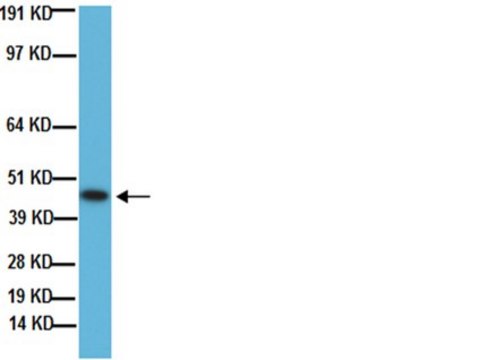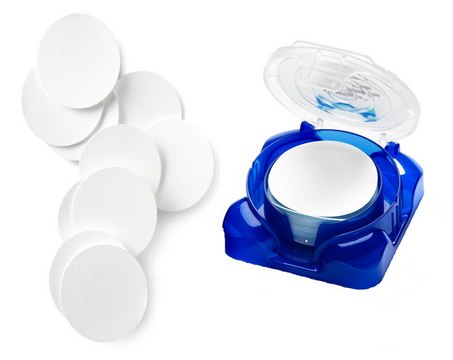MAB3472-I
Anti-Hypoxia Inducible Factor 2α Antibody, clone 190b
Sign Into View Organizational & Contract Pricing
Select a Size
All Photos(2)
Select a Size
Change View
About This Item
UNSPSC Code:
12352203
NACRES:
NA.41
Recommended Products
biological source
mouse
Quality Level
conjugate
unconjugated
antibody form
purified antibody
antibody product type
primary antibodies
clone
190b, monoclonal
mol wt
calculated mol wt 96.46 kDa
purified by
using protein G
species reactivity
human
packaging
antibody small pack of 100 μL
General description
Endothelial PAS domain-containing protein 1 (UniProt: Q99814; also known as EPAS-1, Basic-helix-loop-helix-PAS protein MOP2, Class E basic helix-loop-helix protein 73, bHLHe73, HIF-1-alpha-like factor, HLF, Hypoxia-inducible factor 2-alpha, HIF-2-alpha, HIF2-alpha, Member of PAS protein 2, PAS domain-containing protein 2) is encoded by the EPAS1 (also known as BHLHE73, HIF2A, MOP2, PASD2) gene (Gene ID: 2034) in human. HIF-2a is a transcription factor that is involved in the induction of oxygen regulated genes. It displays about 48% identity to HIF-1a and is widely expressed with high expression observed in endothelial cells. Its levels are strongly induced by hypoxic conditions. HIF- 2a dimerizes with ARNT, via amino acid sequence 171-192, and this heterodimer binds to core DNA sequence 5′-TACGTG-3′ within the hypoxia response element (HRE) of target gene promoters. Its DNA-binding region is localized to amino acids 26-53. It has two PAS (Per-Arnt-Sim) domains (aa 84-154 and 23-300). HIF-2a regulates the vascular endothelial growth factor (VEGF) expression and is implicated in the development of blood vessels and the tubular system of lung and is also involved in the formation of the endothelium that gives rise to the blood brain barrier. Under normoxic conditions it is hydroxylated on proline 405 and 531 prolyl hydroxylase 1 and 2 and the hydroxylated form undergoes rapid ubiquitination and proteasomal degradation. However, under hypoxic conditions, proline hydroxylation is impaired and HIF- 2a is stabilized. Mutations in EPAS1 gene are known to cause familial type erythrocytosis that is characterized by elevated serum hemoglobin and hematocrit with normal platelet and leukocyte counts. (Ref.: Strowitzki, MJ., et al. (2019). Cells. 8(5): 384; Wiesener, MS., et al. (1998). Blood. 92(7); 2260-2268).
Specificity
Clone 190b is a mouse monoclonal antibody that detects Hypoxia-inducible factor 2a. It targets an epitope within the C-terminal half.
Immunogen
GST-tagged recombinant fragment corresponding to 97 amino acids from the C-terminal half of human Hypoxia inducible factor 2a (HIF- 2a).
Application
Quality Control Testing
Evaluated by Immunocytochemistry in hypoxic Jurkat cells.
Immunocytochemistry Analysis (ICC): A 1:500 dilution of this antibody detected HIF-2a in hypoxic Jurkat cells.
Tested Applications
Immunohistochemistry Applications: A representative lot detected Hypoxia Inducible Factor 2 in Immunohistochemistry applications (Hoefflin, R. et al. (2020). Nat Commun.;11(1):4111; Moriyama, H., et al. (2014). Stem Cells Dev.;23(18):2211-24).
Immunohistochemistry (Paraffin) Analysis: A 1:50 dilution from a representative lot detected Hypoxia Inducible Factor 2 in human bone marrow tissue sections.
Immunocytochemistry Analysis: A representative lot detected Hypoxia Inducible Factor 2 in Immunocytochemistry applications (Talks, K.L., et al. (2000). Am J Pathol.;157(2):411-21; Wiesener, M.S., et al. (1998). Blood.;92(7):2260-8).
Western Blotting Analysis: A representative lot detected Hypoxia Inducible Factor 2 in Western Blotting applications (Ma, Y., et al. (2015). EMBO J.;34(3):361-78; Talks, K.L., et al. (2000). Am J Pathol.;157(2):411-21; Wiesener, M.S., et al. (1998). Blood.;92(7):2260-8).
Immunohistochemistry (Paraffin) Analysis: A representative lot detected Hypoxia Inducible Factor 2 in Immunohistochemistry applications (Talks, K.L., et al. (2000). Am J Pathol.;157(2):411-21).
Note: Actual optimal working dilutions must be determined by end user as specimens, and experimental conditions may vary with the end user
Evaluated by Immunocytochemistry in hypoxic Jurkat cells.
Immunocytochemistry Analysis (ICC): A 1:500 dilution of this antibody detected HIF-2a in hypoxic Jurkat cells.
Tested Applications
Immunohistochemistry Applications: A representative lot detected Hypoxia Inducible Factor 2 in Immunohistochemistry applications (Hoefflin, R. et al. (2020). Nat Commun.;11(1):4111; Moriyama, H., et al. (2014). Stem Cells Dev.;23(18):2211-24).
Immunohistochemistry (Paraffin) Analysis: A 1:50 dilution from a representative lot detected Hypoxia Inducible Factor 2 in human bone marrow tissue sections.
Immunocytochemistry Analysis: A representative lot detected Hypoxia Inducible Factor 2 in Immunocytochemistry applications (Talks, K.L., et al. (2000). Am J Pathol.;157(2):411-21; Wiesener, M.S., et al. (1998). Blood.;92(7):2260-8).
Western Blotting Analysis: A representative lot detected Hypoxia Inducible Factor 2 in Western Blotting applications (Ma, Y., et al. (2015). EMBO J.;34(3):361-78; Talks, K.L., et al. (2000). Am J Pathol.;157(2):411-21; Wiesener, M.S., et al. (1998). Blood.;92(7):2260-8).
Immunohistochemistry (Paraffin) Analysis: A representative lot detected Hypoxia Inducible Factor 2 in Immunohistochemistry applications (Talks, K.L., et al. (2000). Am J Pathol.;157(2):411-21).
Note: Actual optimal working dilutions must be determined by end user as specimens, and experimental conditions may vary with the end user
Anti-Hypoxia Inducible Factor 2a , clone 190b, Cat. No. MAB3472-I, is a mouse monoclonal antibody that detects Hypoxia Inducible Factor 2a and is tested for use in Immunocytochemistry, Immunohistochemistry (Paraffin), and Western Blotting.
Physical form
Purified mouse monoclonal antibody IgG1 in buffer containing 0.1 M Tris-Glycine (pH 7.4), 150 mM NaCl with 0.05% sodium azide.
Storage and Stability
Recommend storage at +2°C to +8°C. For long term storage antibodies can be kept at -20°C. Avoid repeated freeze-thaws.
Other Notes
Concentration: Please refer to the Certificate of Analysis for the lot-specific concentration.
Disclaimer
Unless otherwise stated in our catalog or other company documentation accompanying the product(s), our products are intended for research use only and are not to be used for any other purpose, which includes but is not limited to, unauthorized commercial uses, in vitro diagnostic uses, ex vivo or in vivo therapeutic uses or any type of consumption or application to humans or animals.
Not finding the right product?
Try our Product Selector Tool.
Storage Class
12 - Non Combustible Liquids
wgk_germany
WGK 1
Certificates of Analysis (COA)
Search for Certificates of Analysis (COA) by entering the products Lot/Batch Number. Lot and Batch Numbers can be found on a product’s label following the words ‘Lot’ or ‘Batch’.
Already Own This Product?
Find documentation for the products that you have recently purchased in the Document Library.
Our team of scientists has experience in all areas of research including Life Science, Material Science, Chemical Synthesis, Chromatography, Analytical and many others.
Contact Technical Service





